Influence of Different Calcium Compounds and Fruit Development Stages on Yield, Fruit Quality and Shelf Life of ‘Granny Smith’ Apples
Ensieh Ghorbani1, Esmaeil Fallahi2*, Davood Bakhshi3 and Babak Rabiei4
1Date Palm and Tropical Fruits Research Center, Horticultural Science Research Institute, Agricultural Research, Education and Extension Organization (AREEO), Ahvaz, Iran
2Department of Plant Science, University of Idaho, Parma, Idaho, 83660, USA
3Department of Horticultural Science, Faculty of Agricultural Sciences, University of Guilan, Rasht, Iran
4Department of Plant Breeding, Faculty of Agricultural Sciences, University of Guilan, Rasht, Iran
Submission: January 18, 2020; Published: February 02, 2021
*Corresponding author: Esmaeil Fallahi, Professor and Director of Pomology and Viticulture, University of Idaho, Parma, Idaho, USA
How to cite this article: Ensieh G, Esmaeil F, Davood B, Babak R. Influence of Different Calcium Compounds and Fruit Development Stages on Yield, Fruit Quality and Shelf Life of ‘Granny Smith’ Apples. Agri Res & Tech: Open Access J. 2021; 25 (3): 556309. DOI:10.19080/ARTOAJ.2021.25.556309
Abstract
Calcium (Ca) plays major roles on the storage life and quality apples. In this study, the influence of calcium chloride (CaCl2) and two organic calcium compounds including Calcicat and Folical at four different times of application on the quality and shelf life of ‘Granny Smith’ apples during two growing seasons. Quantitative and qualitative attributes were evaluated at harvest and after three- and six-months cold storage. In the first year, Folical all-season and mid-season sprays resulted in a significant increase in Ca concentration. In the second year, early-season spray resulted in significant Ca increase compared to control. In the first year, the early-season spray program of Folical had the highest yield and fruit weight. The use of calcium compounds in all timing programs reduced fruits soluble solids concentration (SSC) at harvest compared to control treatments. In both years, at harvest, no significant difference was observed among treatments regarding the ‘Granny smith’ apple firmness. In the first year, the chlorophyll content of ‘Granny Smith’ apple peels were affected by spray timing and the type of calcium compound. In both years, Fruits treated with Ca had lower ethylene concentration and brightness index (L*) than controls. In the second year, Folical spray decreased the percentage of superficial scald incidence for three months storage. During the first year, all-season Calcicat spray and in the second year early-season Folical spray showed the lowest percentage of scald disorder after six months storage. In the first year, the all-season spray program and in the second year Folical spray decreased the severity of scald after three months of storage.
Keywords: Fruit firmness; Internal ethylene concentration; Shelf life; Spray programs; Superficial scald
Introduction
Fruit quality attributes, including fruit finish are extremely important in any apple (Malus domestica Borkh.) industry, particularly when fruits are shipped for domestic and export markets. Apple fruit quality is a result of many management practices including pollination, pruning, thinning, plant nutrition and crop load, in addition to soil type and weather conditions [1,2]. A well-balanced nutrition program is crucial for high yield and fruit quality [3]. Many fruit quality attributes can be affected by application of calcium (Ca) fertilizers. Calcium (Ca) plays an extremely important role in plant growth and development and in maintaining and modulating various cell functions. It is necessary to maintain membrane stability and is an integral part of the cell wall where it provides rigidity [4]. Calcium also has direct influence on ripening attributes such as respiration, ethylene production, and flesh firmness [5-9]. Enhancing the calcium content of apple fruits can be very beneficial in maintaining fruit quality during storage [10]. Apple tree roots are poor at absorbing Ca from the soil [3]. Because of this, foliar sprays and apple dips are commonly used to increase the Ca content of the fruits. The effect of foliar spraying treatments depends on several factors including foliar spraying techniques, salt concentrations, time and number of treatments, type of fertilizer used and growing season [11].
Different calcium fertilizers are suggested to fruit growers. Experimental results showed different effects of applying calcium fertilizers. In addition, different results of foliar application of calcium compounds at different times have been reported. Some studies have suggested that early and late season spraying is effective in increasing fruit quality [12] and others have recommended late-season spraying [13]. On the other hand, Peryea et al. [14] reported that mid-season CaCl2 spraying appears to be the most economical and effective spray management practice for increasing fruit Ca and reducing risk of bitter pit development. Lötze et al. [15] with the study of three Ca compounds including calcium nitrate, calcium acetate and Calcimax and three spraying programs (start of spraying at various developmental stages, early, mid and late of season) to increase Ca content and to decrease bitter pit stated that in addition to time, compound type is also effective in Ca absorption efficiency by fruits and bitter pit disorder decreasing. Given the above, the objective of this research was to study the pre-harvest foliar-applied effects of calcium chloride and two Ca-containing organic compounds (Calcicat® and Folical®) on fruit quality of ‘Granny Smith’ apples during two growing seasons.
Materials and methods
This study was carried out during two growing seasons. In the first year, this study was conducted at the Haydari’s Orcahrd located in Abhar, Zanjan-Iran and in the second year was conducted at the Taheri’s orchard located in Takestan, Ghazvin-Iran. In both years, the experiment was set up in a commercial orchard of ‘Granny Smith’ apples, grafted on ‘MM106’ rootstock, planted at 2.5 x 4 m spacing in 2006. In this study, two organic Ca compounds namely Calcicat® including 20.5% of calcium as CaO, other elements such as nitrogen, magnesium, iron, manganese and zinc, and trace amounts of organic acids and Folical® including 17% calcium, organic acids and plant system amplifiers and calcium chloride as mineral compound with the control (water) in four different spray programs were compared. 5 g L-1 CaCl2 solution was used [14] and the organic compounds were equal with CaCl2 regarding of Ca content. The four different spray programs were: a) Early season (10-15 days after full bloom (DAFB)) involving 6 biweekly spray starting late May and Late-July, b) Midseason (35 DAFB) involving 6 biweekly spray starting early June and ending Mid-August, c) Late season (60 DAFB) involving 6 biweekly spray starting late June and ending late September and d) All-season (10-15 DAFB) late May and ending late September. In the second year, only Folical was examined during two spray programs including early-season and late-season. In the first year, the CaCl2 solution was prepared in a trailer-mounted 100-L sprayer towed behind a tractor and in the second year, a ten-liter sprayer was used for this purpose. The experimental trees were sprayed to drip. Each experimental unit consisted of six trees distributed along the row, but only the central four plants were used for determinations. The three replicates were arranged in a randomized block design. The experiment area received all management practices used in the commercial orchard including winter and summer pruning, application of insecticides.
In both years, 80 fruits of uniform size and maturity level were randomly collected per replication at the harvest time on late September. The sample fruits were randomly collected from the outside of the middle third of the canopy from all treatment trees. The fruit remaining on the tree after the harvest samples had been removed were counted to determine total crop load. Trunk diameters were measured at same height above the soil line to allow calculation of No. of fruits per cm2 trunk crosssectional area (TCSA). A randomly sample of 30 fruits was used for measurements of mineral nutrient concentration and quality attributes at harvest. The remaining 50 fruits were stored in a commercial cold storage at 0°C and 95% of relative humidity (RH) located in Karaj region, Alborz province, for three and six months prior to determination of fruit quality attributes and storage disorders.
Samples were analyzed for flesh mineral content at harvest. A random sample of 10 fruit was also selected at harvest from each replication. Fruits were cut longitudinally and small wedges from 1cm below the skin were sampled. Mineral analyses were performed at the nutrient analysis laboratory. Ca and Mg content were determined by atomic absorption spectroscopy and K by flame emission [16]. All nutrient content values were expressed as gram per 100-gram dry mass basis. At harvest and after seven days ripening at room temperature following three- and sixmonths storage at 0°C, a randomly selected 10 apple subsamples from all plots was evaluated for flesh firmness, titratable acidity (TA), and soluble solids concentration (SSC). Flesh firmness was measured at two opposite points on the fruit equator (sunny and shady sides) using a penetrometer with an 11.1 mm diameter head and averaged. SSC was determined with a refractometer and TA was measured by titration of juice with 0.1 M NaOH to an 8.1 pH end point.
Total chlorophyll content of apples peel was measured by spectrophotometer (T80+UV/VIS PG Instrument Ltd). Accurately weighted 0.5 g of apple peel was taken, homogenized in a mortar with the addition of 2 mL of 100% acetone as a solvent for extraction. The peel homogenate was centrifuged at 10000g for 10 min. The supernatant was removed and re-extracted. The absorption of the samples was read at two wavelengths of 645 and 670 nm [17]. Total chlorophyll content was calculated using the formula of Lichtenthaler and Buschmann [18] and expressed in milligrams per gram of fresh weight. The internal ethylene concentration (IEC) of Granny Smith apples was measured after three months storage. Five fruits from each replication were used to determine the IEC. For IEC measurement, 5 mL gas sample were withdrawn using a syringe. the samples were analyzed on a GCHP 6890 GC with FID (2010 Shimadzu) detector and glass column. The temperature for the oven, injection port and detector were 100, 120 and 250°C, respectively and the column pressure was one atmosphere. Helium was used as the carrier gas at a flow rate of 30 mL min-1. Ethylene gas concentrations were expressed in μL.L-1.
At harvest, the color of the fruit peels was described using the CIE (L*, C*, and h°) color indicators defined by the International Commission of illumination, in which L* represents the brightness (between zero and one hundred), C* (chroma) expressing light and dark color and h° (color angle) are calculated using these three indicators. For this purpose, five fruits were selected from each replication and after cleaning the surface of the fruits, the skin color of the fruits was measured using a colorimeter (CR400-Minolta). After seven days ripening at room temperature following threeand six-months storage at 0°C, the samples were examined for the incidence of superficial scald incidence percentage and severity. For this purpose, 20 fruits from each replicate were examined. The incidence of disorder was expressed as percentage [19] and the index [20] was used to determine the severity of superficial scald. In the first year, Analysis of variance was performed on all fruit data as a split plot design and in the second year, a factorial design was used to analyze the data. All statistical analyses were undertaken using the general linear model (GLM) procedure of the SAS version 9.0. The Duncan’s multiple range test (P≤0.01) was used to evaluate differences between treatments.
Results and Discussion
Mineral concentration of fruits, at harvest In the first year, fruit Calcium (Ca), potassium (K) and magnesium (Mg) concentrations were significantly affected by the preharvest treatments. The all-season spray program in ‘Granny Smith’ was more effective in increasing the fruit Ca. Folical midseason treatment significantly increased fruit Ca compared to control mid-season (Table 1). In the second year, early-season spray resulted in significant Ca increase compared to control (Figure 1). In the first year, all treated fruits received all- and earlyseason Folical and all-season CaCl2 had higher content of K and fruits treated with Folical late-season and control late-season had higher concentration of Mg (Table 1). In the second year K and Mg concentration was not affected by the treatments.
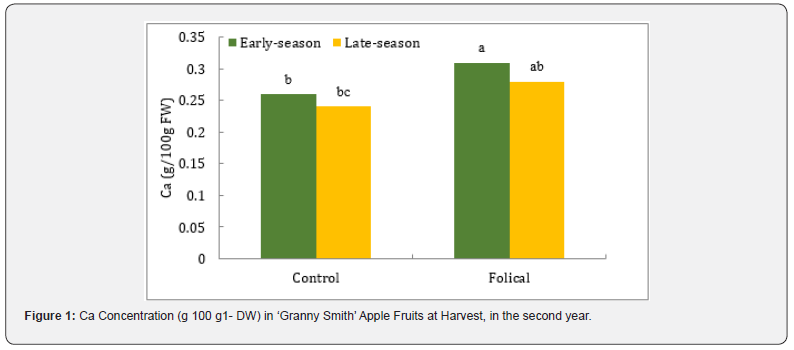
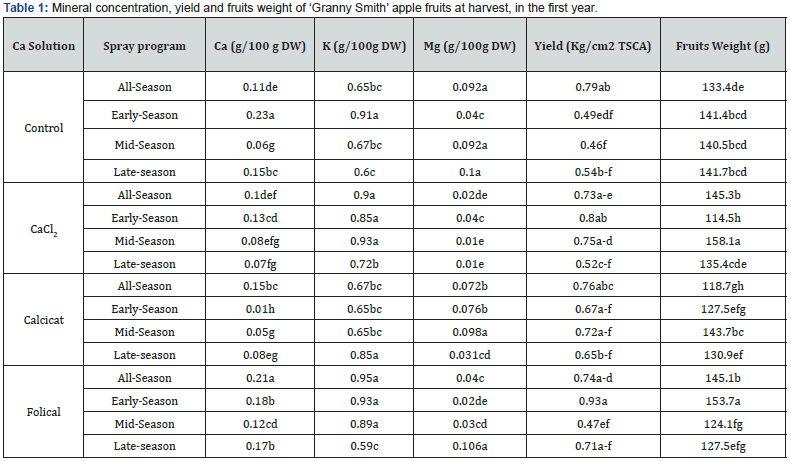
According to the findings of other studies [21-23], different calcium compounds had different effects on increasing of fruits Ca concentration. Application time of calcium compounds also affected the spraying results. The application of CaCl2 and Calcicat had no effect on Ca enhancement, but Folical all-season and midseason spray resulted in a significant increase in Ca concentration compared to the controls (Table 1). Peryea et al. [14] with the study of three calcium chloride foliar application programs (early, mid, and late season) for two years reported that calcium concentration in fruits after the mid- and late-season programs were higher than those treated earlier in the season. They found the mid-season foliar application was more economical and effective. In general, these results confirm the effect of type of calcium compounds and foliar application time on the rate of calcium uptake by fruits [11]. Values of similar letters, within the same column, were not significantly different according to the Duncan’s multiple range test (P≤0.01).
On the other hand, in the second year, foliar application of Folical during the early-season increased concentration of calcium in the “Granny Smith” fruits compared to the control and lateseason program (Figure 1). These results are inconsistent with the study of Schlegel, Schӧnherr [24] results which indicated that the rate of calcium penetration into the fruits decreases with increasing fruit age during the growing season. These results may indicate the importance of fruit size in the amount of calcium absorption by the fruits [25].
According to the results of the first year, foliar application during the all-season (which included a greater number of foliar applications) did not have an effect on increasing the concentration of calcium compared to other foliar application programs. As a result, it can be stated that the time of spraying is more important than the number of sprays.
Yield and fruits weight

Yield efficiency (Kgcm2-TCSA) and fresh fruit weight at harvest affected by used calcium compounds and spray programs. According to table 1, Folical early-season treatment had highest yield and control mid-season had the lowest. In each compound, different spray programs had no significant difference regarding yield. Foliar application of three Ca compounds during all-season showed no significant variation compared to all-season control. While early-season spray programs increased tree yield rather than related control. Application of calcium chloride and Calcicat during the mid-season increased yield. Calcicat and Folical spray during late of season increased tree yield; however, this difference was not statistically significant (Table 1). In the second year, yield of the trees was affected by Ca compounds. As Figure 2 shows, Folical foliar application reduced the yield of trees compared to control, while in the first year the opposite was observed. In Rosenberger et al. [26] study, the yield of trees decreased under the influence of calcium foliar application, which confirms our findings during the second year. The early-season spray program of Folical and CaCl2 had the highest and lowest fruit weight respectively (Table 1), whereas in the second year, late-season spray program had higher weight than early-season spray (Figure 3). Various results have been reported on the effect of calcium on fruit size [25-27].
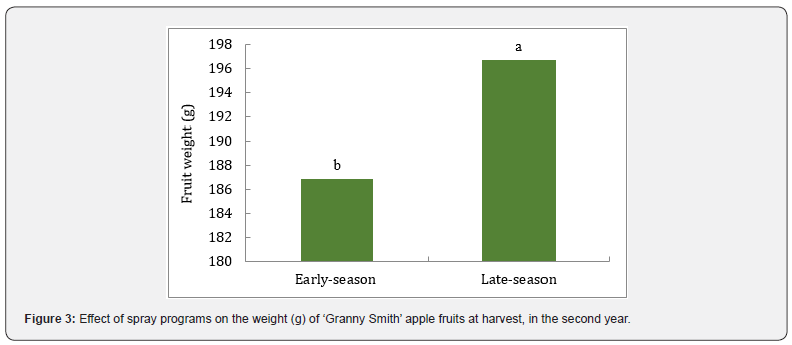
Soluble solids concentration at harvest
In the first year, SSC was affected by Ca application and spray programs at harvest and during three- and six-months storage. According to the results, Folical mid-season, control early and lateseason and CaCl2 late-season treatments showed the highest SSC and CaCl2 all-season showed the lowest concentration (Table 2). In the second year, fruits SSC was affected by spray programs and spraying during the late season increased the fruits SSC (Figure 4).
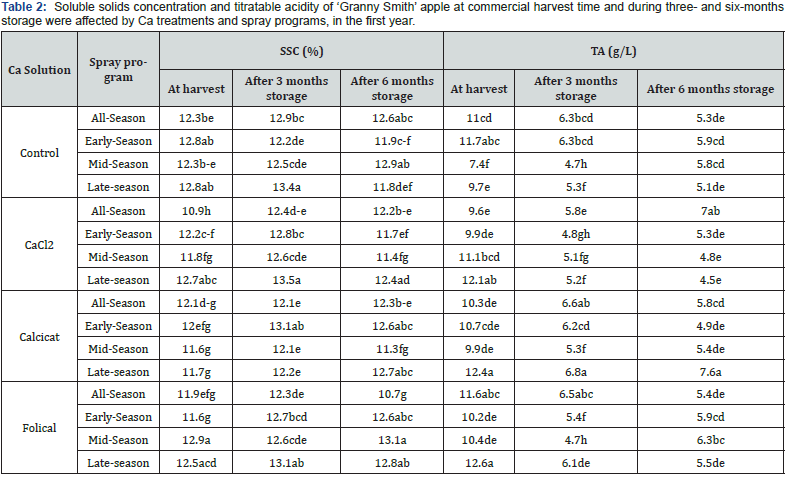

Table 2: Soluble solids concentration and titratable acidity of ‘Granny Smith’ apple at commercial harvest time and during three- and six-months storage were affected by Ca treatments and spray programs, in the first year. Values of similar letters, within the same column, were not significantly different according to the Duncan’s multiple range test (P≤0.01). During the first year, no specific pattern was observed in terms of the effect of calcium compounds on reducing or increasing SSC at harvest. The use of calcium compounds in all timing programs reduced the amount of SSC at harvest compared to control treatments, but this reduction was not significant for all treatments (Table 2). Various results have been reported on the effect of calcium on SSC levels [28- 31]. Our results agree with the findings of Dris and Niskanen [31] on reducing fruits SSC following the use of calcium compounds. Nielsen et al. [25] found that the SSC value of apple fruit was not affected by different spray programs (early, mid, and late season) of calcium chloride. Decreased SSC in treated fruits is probably due to the fact that calcium decreases respiration and metabolic activity, thus delay the process of fruits ripening [32,33].
Soluble solids concentration during storage
In the first year, significant variation observed among treatments regarding of SSC after three- and six-months storage. CaCl2 late-season and Folical mid-season had the highest SSC after three- and six-months storage, respectively (Table 2). In the second year, fruits SSC was affected by Ca and spray programs after six months storage and Folical late season showed the highest content of it (Figure 5). For three months storage, the fruits SSC increased, but in some treatments, after six months storage, SSC decreased compared to fruits SSC at harvest and after three months storage (Table 2). This trend was also observed in the second year. Mahajan [34] and IhI et al. [35] reported similar results in the ‘Red Delicious’ and ‘Granny Smith’ apples. They stated that the initial increase in SSC values is due to the hydrolysis of starch into sugars, which cannot increase after the end of starch hydrolysis. Thus, it can be stated that in this storage conditions, six months storage is not recommended for ‘Granny Smith’ apples, and the maximum storage period in these conditions needs to be studied.
Titratable acidity at harvest
In the first year, Folical late-season and control mid-season showed the highest and the lowest TA concentration at harvest (Table 2). In the second year, late-season spray had the higher TA compared to the early-season spray (Figure 6). Various results have been reported on the effect of calcium on the amount of TA [25,36,37]. In our study (Table 2), no specific trend was observed and the effect of compounds on TA levels varied depending on the foliar application time.
Titratable acidity after storage
In the first year, fruits TA was affected by the studied treatments after three- and six-months storage (Table 2). In the second year, the effect of Ca solution on fruits TA was significant after three months storage and fruits received Folical had more TA than control (Figure 7). As previous findings have reported [35, 36] the amount of TA in the fruits reduced during storage. This reduction did not have a clear trend between control and treated fruits. However, as the data suggest, fruits TA decreased sharply during storage, which, according to the results of Jinhe et al. [38], fruits that have a high TA at harvest time show a further decrease during storage.

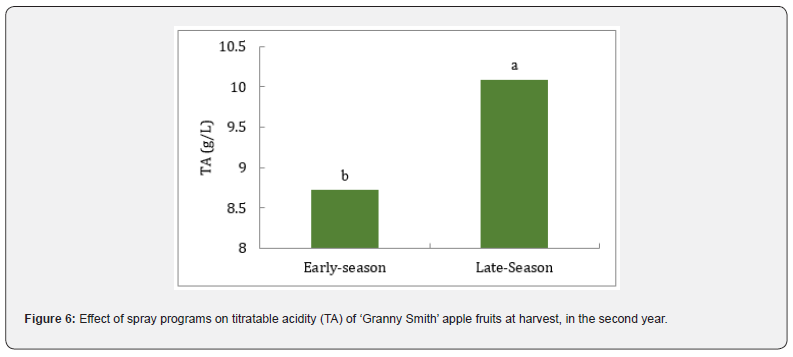
Firmness at harvest
In both years, at harvest, no significant difference was observed among treatments regarding firmness of ‘Granny smith’ apples.
Firmness during storage
In the first year, after three- and six-months storage, flesh firmness of apple fruits was influenced by preharvest treatments as recorded in Table 3. Control late-season showed the highest flesh firmness and CaCl2 all-, early- and mid-season showed the lowest, after three months storage. For six months storage, Folical and control early-season had the highest firmness and Calcicat early-season had the lowest of it (Table 3). In the second year, apple tissue firmness was not affected by Ca treatments during threeand six-months storage. There are conflicting reports regarding the relationship between calcium levels and fruit firmness. According to some studies, firmness of fruit tissue increases with increasing calcium content of fruit [39,40], and according to some other studies, firmness of fruit tissue is not affected by pre-harvest foliar application of calcium chloride or other calcium solutions [41]. In this investigation, calcium solution did not increase the tissue firmness of the fruits compared to the control. During the second year, the firmness of the ‘Granny Smith’ apple fruits was not affected by the Folical foliar application and the spraying times. Ernani et al. [1] and Wojcik et al. [29] also reported that the use of calcium compounds had no effect on the firmness of ‘Gala’ and ‘Granny Smith’ fruits. As the data show, the firmness of the fruit tissue in the second year was less than in the first year, which can be attributed to the bigger size of apple fruits during the second year.
According to Table 3, The firmness of the fruits tissue reduced during storage. Mature apples undergo changes of ripening process during storage, which involve cell wall degradation by the enzymes polygalacturonase and pectin methyl esterase [42, 43]. The result of these changes is a reduction in the firmness of the fruit tissue and, as a result, an increase in susceptibility to fungal pathogens [44]. In fact, storage at low temperatures, due to the degradation of the middle membrane and cellular separation, leads to a reduction in the fruit tissue firmness [8,45]. As the data show (Table 3), calcium treatments reduced fruit tissue firmness less than control fruits. Calcium reduces the sensitivity of the cell wall to enzymatic hydrolysis by inhibiting the activity of the enzymes polygalactornase and pectin methyl esterase, as well as by binding to cellular polymers, and prevents the breakdown and disintegration of cells [46-49].
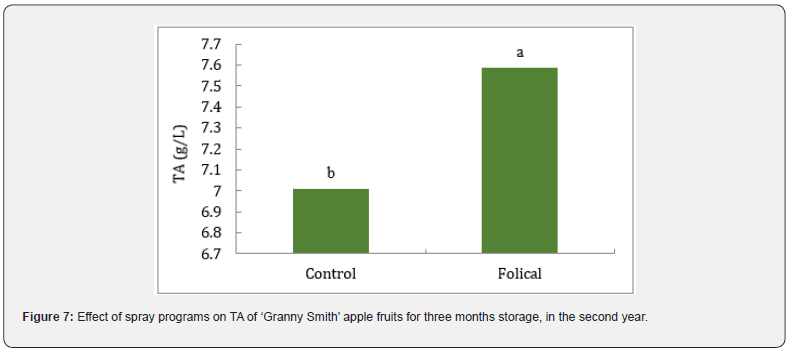
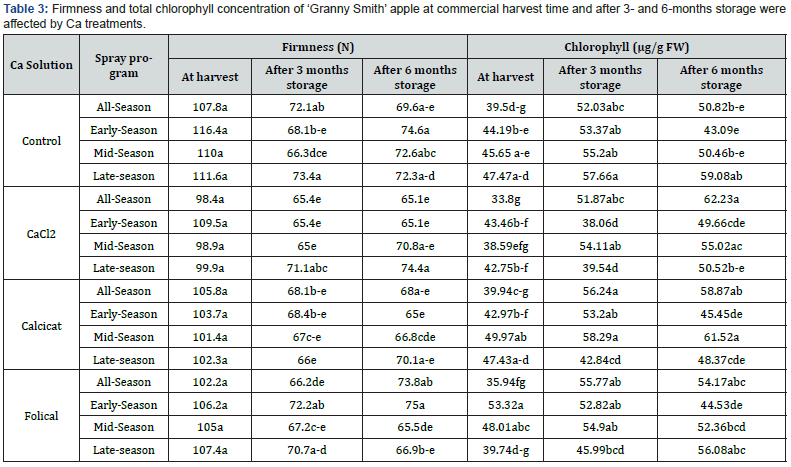
Total chlorophyll concentration at harvest
According to the results, significant difference was observed among treatments regarding total chlorophyll of apple peels, in the first year. In the second year, there was no significant difference among fruits. According to the data (Table 3), the effect of each calcium compound was different depending on the time of application. The highest concentration of chlorophyll found in fruits treated with Folical during early of fruits growth steps and the lowest found in CaCl2 all-season treatment. The application of different calcium solutions during all, mid and late-season did not have a significant effect compared to the corresponding control fruits. Only the Folical early-season spray increased the concentration of chlorophyll relative to the control early-season, significantly.
Total chlorophyll concentration during storage
In the first year, chlorophyll content of apple peels was affected by preharvest application of Ca and spray programs after threeand six- months storage. After six months storage, the highest chlorophyll found in CaCl2 all-season and Calcicat mid-season and the lowest chlorophyll concentration found in control earlyseason (Table 3).
In the second year, chlorophyll concentration was affected by Ca solution for three months storage and fruits received Folical had higher chlorophyll compared to the control (Figure 8). After six months storage, it was affected by Ca and spray programs and Folical late-season had the highest concentration (Figure 9). Various results have been reported regarding the effect of calcium on the synthesis and accumulation of chlorophyll. Knypl and Rennert [50] stated that potassium and calcium play a prominent role in chlorophyll accumulation. Calcium spraying on wheat has increased chlorophyll levels [51], while Calcium spraying on apple fruits, has reduced chlorophyll [30]. As the data show, unlike Rutkowski et al. [52] report, the amount of chlorophyll in the peel of fruits fluctuates during three and six months of storage, but in general, the chlorophyll content of fruits peel increased with the exception of Folical early-season (Table 3). The results of the second year also confirmed the observed results during the first year.
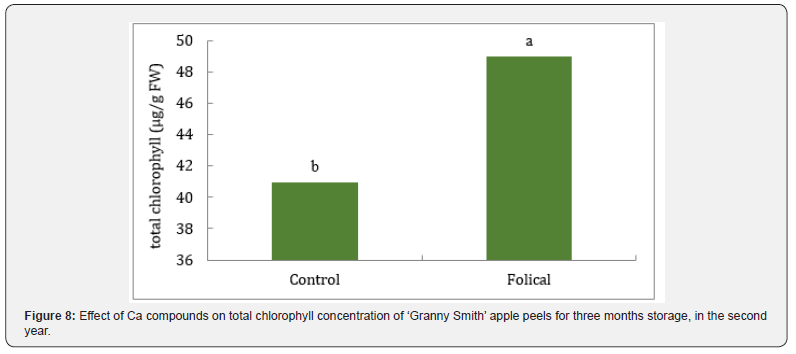
Internal ethylene concentration (IEC) for three months storage
In both years, there was a significant variation among treatments regarding internal ethylene concentration, after three months storage. As the data show (Table 4), calcium compounds had different effects on fruit ethylene production depending on the time of application. In the first year (Table 4), foliar application of calcium compounds during all-season did not have a significant effect on ethylene concentration. Early-season CaCl2 and Folical spray significantly reduced ethylene levels compared to control early-season treatment. The use of the studied calcium compounds during the mid-season reduced the concentration of internal ethylene in fruits compared to control, significantly. About lateseason spray program, only Folical solution significantly affected the production of internal ethylene concentration and reduced the concentration of ethylene compared to control fruits. The use of Folical late-season in the second year had the same effect (Figure 10). Values of similar letters, within the same column, were not significantly different according to the Duncan’s multiple range test (P≤0.01). The reduction in the ethylene concentration of the fruits was consistent with the findings of Fallahi et al. [53], Saftner et al. [54], Sams and Conway [55]. Calcium affects the structure and function of cell membranes, and by binding enzymatic and non-enzymatic proteins to cell membrane phospholipids, reduces the activity of ethylene-producing enzymes that have a protein structure and are attached to the cell membrane and thereby slightly retarding the climacteric rise and reducing the climacteric maximum and preventing softness [53,56].
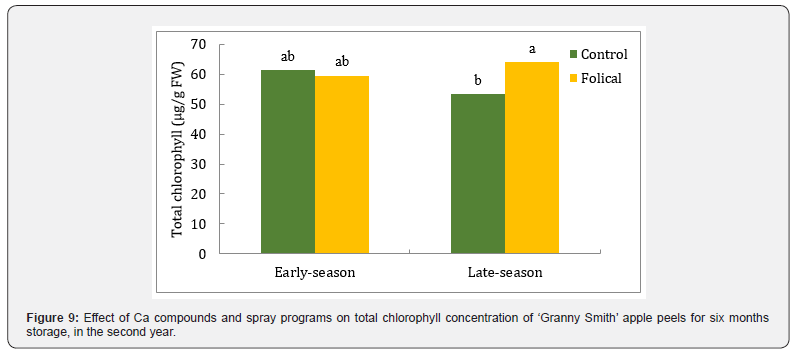
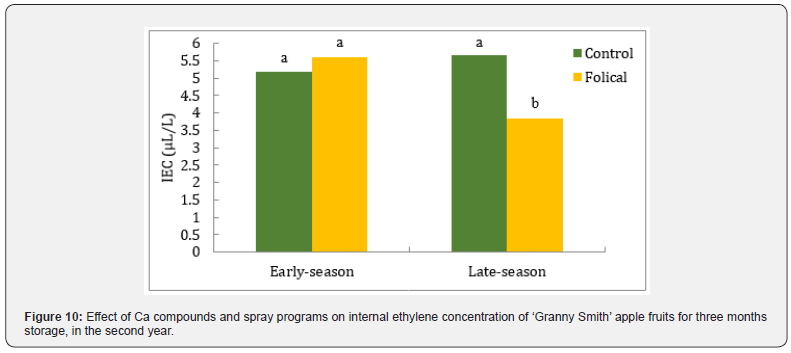
Color Indices of fruits peel at harvest
In the first year, the L* index of fruits peel was affected by the simple effect of calcium solution and the interaction of calcium solution × spray programs. C* and h° indices were not affected by any of the treatments. As the data show (Table 4), fruits treated with calcium solutions had a lower brightness index (L*) than control fruits. In the second year, only the interaction of calcium solution and spray programs was significant regarding L* index (Figure 11). The two indices C* and h° were not affected by the studied treatments. The L* reduction as a result of the use of calcium compounds is consistent with the findings of Sharma et al. [57].
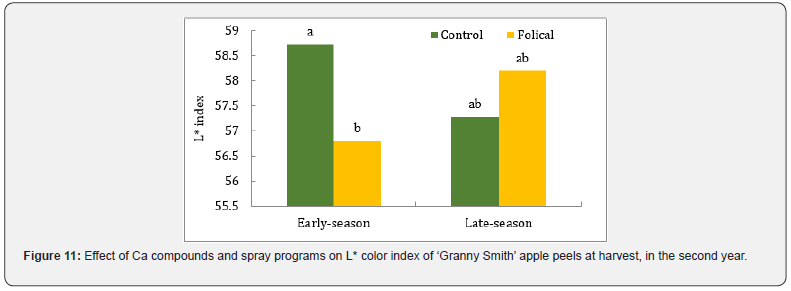
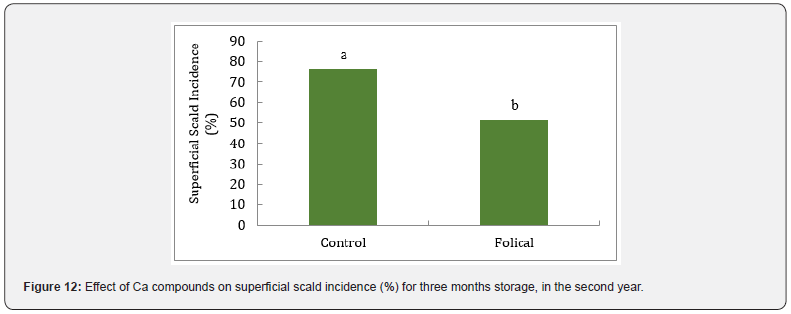
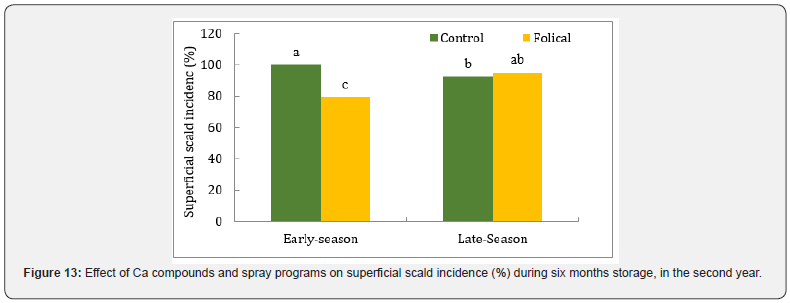
Incidence of percentage of superficial scald for three months storage
In the first year, the percentage of superficial scald incidence was not affected by preharvest treatments for three months storage. But in the second year, the effect of Ca solution on incidence of superficial scald was significant. Folical application reduced the incidence of this storage disorder after three months storage (Figure 12). In both years, there was significant variation among treatments regarding scald incidence for six months storage. During the first year, the incidence percentage was 100 with the exception of Calcicat all-season (Table 4). In the second year, Folical early-season showed the lowest percentage of scald incidence compared to the control and Folical late-season and the highest percentage of disorder was observed in the control earlyseason fruits (Figure 13).
Scald severity for three months storage:
In the first year, scald severity was affected by spray programs for three months storage and in the second year was affected by Ca solution. In the first year, the severity of the scald disorder was not affected by the different calcium solutions. But the severity of scald in the treated fruits during all-season was significantly lower than other three spraying programs (Figure 14). However, during the second year, the severity of this disorder was significantly lower in the treated fruits with Folical compared to control fruits (Figure 15). According to the results, there was significant difference among calcium compounds regarding scald severity. The severity of scald was significantly lower in the fruits treated with Calcicat solution compared to control and fruits treated with calcium chloride and Folical (Figure 16). In the second year, scald severity was affected by spray programs and Ca. the scald severity was significantly lower in the Folical early-season treatment than others (Figure 17). Previous studies have shown that scalds are more in products harvested after a hot-dry summer than fruits harvested during the humid summer. But in the present study, during the first year when the weather was cooler and the humidity was higher, the percentage and severity of the disorder was higher than in the second year (especially after three months storage).
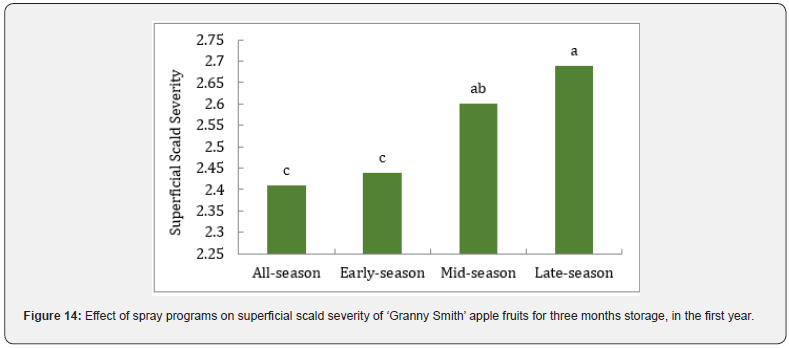
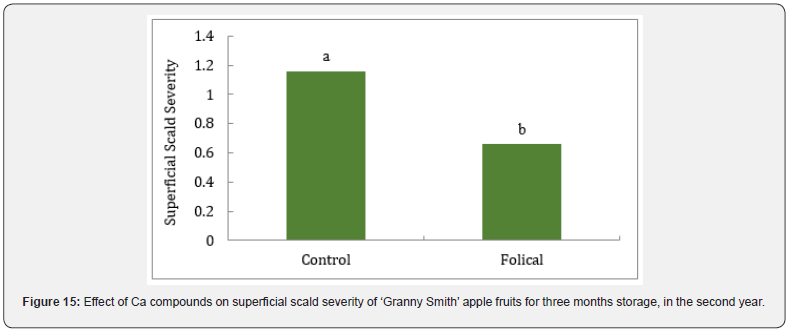
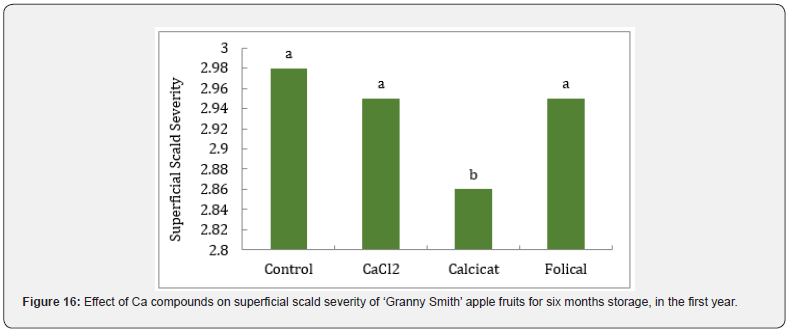
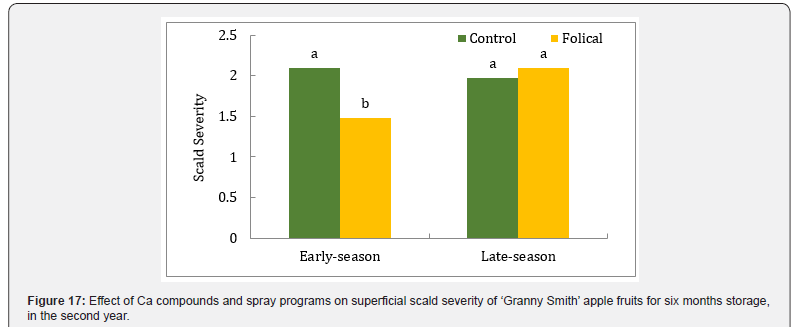
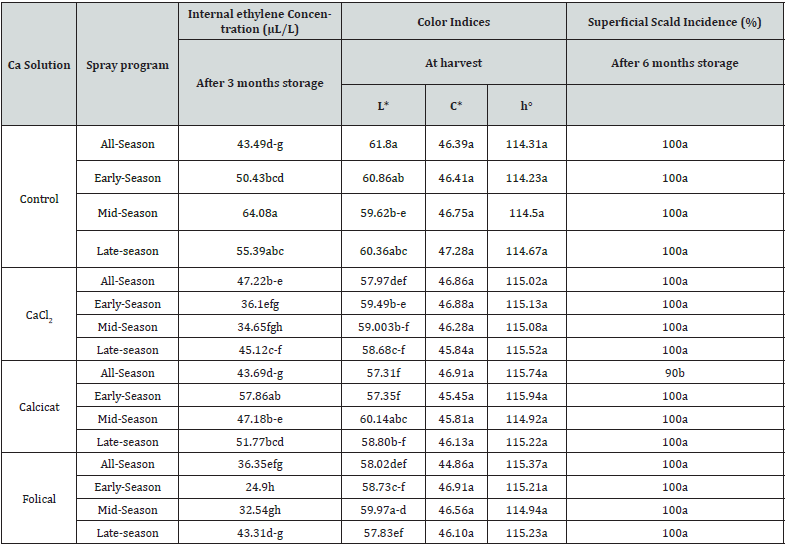
Conclusions
According to this study, various calcium compounds, stages of fruit development and time of application had different effects on fruit quality attributes of ‘Granny Smith’ apple. The impact of time of spray was more important than the number of sprays on fruit quality. Application of calcium chloride and Calcicat during the mid-season increased yield. In the second year, Folical foliar application reduced the yield of trees, while in the first year, different result was observed. According to yield data in both years (Table 1 & Figure 1), trees yield in the first year was higher than the second year. Different results in both years regarding SSC, TA and Firmness can be due to differences in trees yield during the studies years [39]. In both years, Fruits treated with Ca had lower ethylene concentration and brightness index (L*) than controls. According to the both years results, Folical and Calcicat compounds (Figure 15-17) and early-season spray program (Figure 14 & 17) were more effective in improving of superficial scald disorders, which needs further study
References
- Ernani PR, Dias J, Do Amarante CVT, Ribeiro DC, Rogeri D (2008) Preharvest calcium sprays were not always needed to improve fruit quality of ‘Gala’ apples in Brazil.Revista Brasilian de Fruticalture 30(4): 892-896.
- Fallahi E, Simons BR (1993) Influence of fruit spacing on fruit quality and mineral partitioning of ‘Redchief Delicious’ apple under full crop conditions. Fruit Varieties Journal 47(3): 172-178.
- Drkenda P, Osmanović H, Begić-Akagić, A, Hudina M, Čivić H, Durić S, Murtić S (2013) Calcium foliar application in function of apple fruit quality preserving. 23rdInternational scientific-experts congress on agriculture and food industry Izmir, Turkey.
- Conway WS, Sams CE, HickeyKD (2002) Pre- and postharvest calcium treatment of apple fruit and its effect on quality. Acta Horticulturae 594: 413-419.
- Fallahi E, Conway W, Hickey KD, Sams CC (1997) The role of calcium and nitrogen in post-harvest quality and disease resistance of apple. HortScience 32(5): 831-835.
- Fallahi E,Fallahi B,Retamales JB, Valdes C, Tabatabaei SJ (2002) Prediction of apple fruit quality using preharvest mineral nutrients.Acta Horticulturae 594: 427-433.
- Beavers WB, Sams CE, Conway WS, Brown GA (1994) Calcium source affects calcium content, firmness and degree of injury of apples during storage. HortScienc, 29(2): 1520-1523.
- Siddiqui S, Bangerth F (1996) The effect of calcium infiltration on structural changes in cell walls of stored apples. Journal of Horticultural Science 71(5): 703-708.
- Malakouti JM, tabatabaei SJ, Shahabil A, Fallahi E (2008) Effects of calcium chloride on apple fruit quality of trees grown in calcareous soils. Journal of Plant nutrition 22(9): 1451-1456.
- Fallahi E, Righetti TL, Wernz JG (1987) Effects of dip and vacuum infiltrations of various inorganic chemicals on postharvest quality of apple. Communication in Soil Science and Plant Analysis 18(9): 1017-1029.
- Lanauskas J, Kviklienė N (2006) Effect of calcium foliar application on some fruit quality characteristics of ‘SinapOrlovskij’ apple. Agronomy Research 4(1): 31-36.
- Raese JT, Drake SR (2002) Ca spray materials and fruit Ca concentrations influence on apple quality. Journal of the American Pomological Society 56(3): 136-143.
- Casero T, Benavides A, Recasens I, Rufat J (2002) Preharvest calcium sprays and fruit calcium absorption in ‘Golden’ apples. Acta Horticulturae 594: 421.
- Peryea FJ, Neilsen GH Faubion D (2007) Start-timing for calcium chloride spray programs influences fruit calcium and bitter pit in ‘Braeburn’ and ‘Honeycrisp’ apples. Journal of Plant Nutrition 30(8): 1213-1227.
- Lӧtze E, Joubert J, Theron KI (2008) Evaluating pre-harvest foliar calcium applications to increase fruit calcium and reduce bitter pit in ‘Golden Delicious’ apples. Scientia Horticulturae 116(3): 299-304.
- Waling I, Van Vark W, Houba V, VdlJJ (1988) Soil and plant analysis, a series of syllabi. Part 7, plant analysis procedure. (4th), Wageningen Agricultural University, Department of Soil Science and Plant Nutrition, Wageningen, Netherland.
- Fouche JR, Roberts SC, Midgley SJE, Steyn WJ (2010) Peel color and Blemishes in ‘Granny Smith’ apples in relation to canopy light environment. HortScience 45(6): 899-905.
- Lichtenthaler HK, Buschmann C (2001) Chlorophylls and carotenoids: measurement and characterization by UV-VIS Spectroscopy. Current Protocols in Food Analytical Chemistry1(1): F4.3.1-F4.3.8.
- Watkins CB, Nock JF, Whitaker BD (2000) Responses of early, mid, and late sea-son apple cultivars to postharvest application of 1-methylcyclopropene (1-MCP) under air and controlled atmosphere storage conditions. Postharvest Biology and Technology 19(1):17–32.
- Wang Z, Dilley DR (2000) Initial low oxygen stress controls superficial scald of apples. Postharvest Biology and Technology 18(3): 201-213.
- Wooldridge J, Joubert M (1997) Effect of Calcimax on fruit quality parameters in apples and plums. Deciduous Fruit Grower47(1): 30-34.
- Moor U, Toome M, Luik A (2006) Effects of different calcium compounds on postharvest quality of apples. Agronomy Research 4(2): 543-548.
- Guerra M, Marcelo V, Valenciano JB, Casquero PA (2011) Effect of organic treatments with calcium carbonate and bio-activator on quality of ‘Reinette’ apple cultivars. Scientia Horticulturae129(2): 171-175.
- Schlegel TK, Schӧnherr J (2002) Stage of developmental affects penetration of calcium chloride into apple fruits. Journal of Plant Nutrition and Soil Science 165(6): 738-745.
- Neilsen G, Neilsen D, Dong Sh, Toivonen P, Peryea F (2005) Application of CaCl2 sprays earlier in the season may reduce bitter pit incidence in ‘Braeburn’ apple. HortScience 40(6): 1850-1853.
- Rosenberger DA, Schupp JR, Hoying SA, Cheng L, Watkins CB (2004) Controlling bitter pit in ‘Honeycrisp’ apples. Horttechnology14(3): 342-349.
- Kadir SA (2005) Fruit quality at harvest of “Jonathan” apple treated with foliarly-applied calcium chloride. Journal of Plant Nutrition 27(11): 1991-2006.
- Casero T, Benavides AL, Recasens I (2009) Interrelation be-tween fruit mineral content and prehar vest calcium treat-ments on ‘Golden Smoothee’ apple quality. Journal of Plant Nutrition 33(1): 27–37.
- Wojcik P, Gubbuk H, Akgul H, Gunes E, Ucgun K, Kucukyumuk C (2010) Effect of autumn calcium spray at a high rate on ‘Granny Smith’ apple quality and storability. Journal of Plant Nutrition 33(1): 46-56.
- Farag KM, Nagy NMN (2012) Effect of pre- and post- harvest calcium and magnesium compounds and their combination treatments on “Anna” apple fruit quality and shelf life. Journal of Horticultural Science & Ornamental Plants 4(2): 155-168.
- Dris R, Niskanen R (1999) Calcium chloride sprays decrease physiological disorders following long-term cold storage of apple. Plant Foods for Human Nutrition 54:159-171.
- El-Shazly SM, Eisa AM, Moatamed AMH, Kotb HRM (2013) Effect of some agro-chemicals preharvest foliar application on yield and fruit quality of “Swelling” peach trees. Alexandria Journal of Agricultural Research58(3): 219-229.
- Rohani MY, Zaipun MZ, Norhayati M (1997) Effect of modified atmosphere on the storage life and quality of “Eksotika” papaya. Journal of Tropical Agriculture and Food Science25: 103-113.
- Mahajan BVC (1994) Biochemical and enzymatic changes in apple during storage. Journal of Food Science and Technology 31(2): 142-144.
- IhI M, Martin AS, Bifani V (2000) Chlorophyllase and quality of Granny Smith apples during storage. Gartenbauwissenschaft, 65(6): 266-271.
- Guerra M, Valenciano JB, Marcelo V, Casquero PA (2010) Storage behavior of ‘Reinette du Canada’ apple cultivars. Spanish Journal of Agricultural Research 8(2): 440-447.
- Duque P, Barreiro MG, Arrabaca JD (1999) Respiratory metabolism during cold storage of apple fruit. I. Sucrose metabolism and glycolysis. PhysiologiaPlantrum107(1): 14-23.
- Jinhe B, Baldwin A, Goodner KL, Mattheis JP, Brecht JK (2005) Response of four apple cultivars to 1-methylcyclopropene treatment and controlled atmosphere storage. HortScience 40(5): 1534-1538.
- Fallahi E, Righetti TL, Richardson DG (1985) Predictions of quality by preharvest fruit and leaf mineral analyses in 'starkspur Golden Delicious’ apple. Journal of the American Society for Horticultural Science110: 524–527.
- Solhjoo S, Gharaghani A, Fallahi E (2017) Calcium and potassium foliar sprays affect fruit skin color, quality attributes, and mineral nutrient concentrations of ‘Red Delicious’ apples.International Journal of Fruit Science 17(4): 358-373.
- Bramlage WJ, Drake M., Baker JH (1974) Relationships of calcium content to respiration and postharvest condition of apples. Journal of American Society for Horticultural Science99: 376-378.
- Bartley IM, Knee M (1981) The chemistry of textural changes in fruit during storage. Food Chemistry9(1-2): 47-58.
- Knee M (1977) Metabolism of polymethylgalacturonate in apple fruit cortical tissue during ripening. Phytochemistry17(8): 1261-1264.
- Conway WS, Gross KC, Sams CE (1987) Relationship of bound calcium and inoculum concentration to the effect of postharvest calcium treatment on decay of apples by Penicillium expansum. Plant Disease71: 78-80.
- Chardonnet CO, Charron CS, Sams CE, Conway WS (2003) Chemical changes in the cortical tissue and cell wall of calcium-infiltrated ‘Golden Delicious’ apples during storage. Postharvest Biology and Technology 28(1): 97-111.
- Fallahi E, Conway W, Hickey KD, Sams CC (1997) The role of calcium and nitrogen in post-harvest quality and disease resistance of apple. HortScience 32: 831-835.
- Poovaiah BW, Glenn GM, Reddy ASN (1988) Calcium and fruit softening: physiology and biochemistry. Horticultural Reviews10: 107-152.
- Wu QD, Szakacs-Dobozi M, Hemmat M, Hrazdina G (1993) Endopolygalacturonase in apples (Malus domestica) and its expression during ripening. Plant Physiology 102(1): 219-225.
- Jauneau A, Cabin-Flaman A, Verdus MC, Ripoll C, Thellier M (1994) Involvement of calcium in the inhibition of endopolygalacturonase activity in epidermis cell wall of Linumusitatissimum. Plant Physiology and Biochemistry 32: 839-846.
- Knypl JS, Rennert A (1970) Stimulation of growth and chlorophyll synthesis in detached cotyledons of cucumber by potassium. Z Pflanzenphysiol 62:97–107.
- Dolatabadian A, Sanavy SA, Gholamhoseini M, Joghan AK, Majdi M, et al., (2013) The role of calcium in improving photosynthesis and related physiological and biochemical attributes of spring wheat subjected to simulated acid rain. Physiology and Molecular Biology of Plants19(2):189-198.
- Rutkowski KP, Michalczuk B, Konopacki P (2008) Nondestructive determination of Golden Delicious apple quality and harvest maturity. Journal of Fruit and Ornamental Plant Research 16: 39-52.
- Fallahi E, Richardson DG, Westwood MN, Chaplin MH (1985) Relationships among mineral nutrition, ethylene and post-harvest physiology in apples on six rootstocks. Scientia Horticulturae 25(2): 163–175.
- Saftner RA, Conway WS, Sams CE (1999) Postharvest calcium infiltration alone and combined with surface coating treatment influence volatile levels, respiration, ethylene production, and internal atmospheres of ‘Golden Delicious’ apples. Journal of the American Society for Horticaltural Science124(5): 553-558.
- Sams CE, Conway WS (1984) Effect of calcium infiltration on ethylene production, respiration rate, soluble polyuronide content and quality of "Golden Delicious" apple fruit. Journal of the American Society for Horticultural Science 109(1): 53-57.
- Recasens I, Benavides A, Puy J, Casero T (2004) Pre-harvest calcium treatments in relation to the respiration rate and ethylene production of ‘Golden Smoothee’ apples. J. Sci. Food Agr84(8): 765–771.
- Sharma RR, Singh D, Pal RK (2013) Synergistic influence of pre-harvest calcium sprays and postharvest hot water treatment on fruit firmness, decay, bitter pit incidence and postharvest quality of royal delicious apples (Malus x domestica Borkh.). American Journal of Plant Sciences 4: 153-159.






























